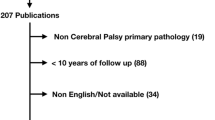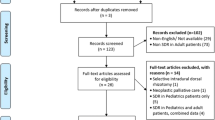Abstract
Purpose
This study examines long-term benefit on functional outcomes and quality of life after selective dorsal rhizotomy (SDR) in children with spastic diplegia in Hong Kong.
Method
This is a case control study. Individuals with spastic diplegia who were at 6 to 12 years post-SDR were recruited. Age, gender, cognition, and Gross Motor Function Classification System level-matched individuals with spastic diplegia who had not undergone SDR were recruited as controls. Outcome measures included physical level, functional level, physiological level, and quality of life. All data were compared by independent t-test.
Results
Individuals post-SDR (n = 15) demonstrated a significantly better range of ankle dorsiflexion in knee extension by − 5.7 ± 10.9° than the control group (n = 12). No other significant differences were observed.
Conclusion
SDR is a safe, one-off procedure and provides long-term reduction in spasticity with no major complications. With the heterogeneity, we did not demonstrate between-group differences in long-term functional outcomes.
Similar content being viewed by others
References
Rosenbaum P, Paneth N, Leviton A et al (2007) A report: the definition and classification of cerebral palsy April 2006. Dev Med Child Neurol Suppl 109:8–14
Oskoui M, Coutinho F, Dykeman J et al (2013) An update on the prevalence of cerebral palsy: a systematic review and meta-analysis. Dev Med Child Neurol 55:509–519. https://doi.org/10.1111/dmcn.12080
Yam WKL, Chan HSS, Tsui KW et al (2006) Prevalence study of cerebral palsy in Hong Kong children. Hong Kong Med J 12:180–184
Smithers-Sheedy H, McIntyre S, Gibson C et al (2016) A special supplement: findings from the Australian Cerebral Palsy Register, birth years 1993 to 2006. Dev Med Child Neurol 58(Suppl 2):5–10. https://doi.org/10.1111/dmcn.13026
Rosenbaum PL, Walter SD, Hanna SE et al (2002) Prognosis for gross motor function in cerebral palsy: creation of motor development curves. JAMA 288:1357–1363. https://doi.org/10.1001/jama.288.11.1357
Peacock WJ, Arens LJ (1982) Selective posterior rhizotomy for the relief of spasticity in cerebral palsy. S Afr Med J 62:119–124
Funk JF, Panthen A, Bakir MS et al (2015) Predictors for the benefit of selective dorsal rhizotomy. Res Dev Disabil 37:127–134. https://doi.org/10.1016/j.ridd.2014.11.012
Munger ME, Aldahondo N, Krach LE et al (2017) Long-term outcomes after selective dorsal rhizotomy: a retrospective matched cohort study. Dev Med Child Neurol 59:1196–1203. https://doi.org/10.1111/dmcn.13500
Ailon T, Beauchamp R, Miller S et al (2015) Long-term outcome after selective dorsal rhizotomy in children with spastic cerebral palsy. Childs Nerv Syst 31:415–423. https://doi.org/10.1007/s00381-015-2614-9
Chan SH-S, Yam KY, Yiu-Lau BP-H et al (2008) Selective dorsal rhizotomy in Hong Kong: multidimensional outcome measures. Pediatr Neurol 39:22–32. https://doi.org/10.1016/j.pediatrneurol.2008.03.017
Bohannon RW, Smith MB (1987) Interrater reliability of a Modified Ashworth Scale of muscle spasticity. Phys Ther 67:206–207. https://doi.org/10.1093/ptj/67.2.206
Committee ATS, on Proficiency Standards for Clinical Pulmonary Function Laboratories (2002) ATS statement: guidelines for the six-minute walk test. Am J Respir Crit Care Med 166:111–117. https://doi.org/10.1164/ajrccm.166.1.at1102
Read HS, Hazlewood ME, Hillman SJ et al (2003) Edinburgh Visual Gait Score for use in cerebral palsy. Journal of Pediatric Orthopaedics 23:296–301. https://doi.org/10.1097/01241398-200305000-00005
Davis E, Mackinnon A, Davern M et al (2013) Description and psychometric properties of the CP QOL-Teen: a quality of life questionnaire for adolescents with cerebral palsy. Res Dev Disabil 34:344–352. https://doi.org/10.1016/j.ridd.2012.08.018
Ngai SPC, Wong LY, Poon VWK et al (2023) Translation and validation of Cerebral Palsy Quality of Life Questionnaire-Teen in Hong Kong Chinese population [CP QoL-Teen (HK)]. Eur J Pediatr 182:1719–1730. https://doi.org/10.1007/s00431-023-04845-0
Dudley RWR, Parolin M, Gagnon B et al (2013) Long-term functional benefits of selective dorsal rhizotomy for spastic cerebral palsy. J Neurosurg Pediatr 12:142–150. https://doi.org/10.3171/2013.4.PEDS12539
Cole GF, Farmer SE, Roberts A et al (2007) Selective dorsal rhizotomy for children with cerebral palsy: the Oswestry experience. Arch Dis Child 92:781–785. https://doi.org/10.1136/adc.2006.111559
Robinson LW, Clement ND, Herman J, Gaston MS (2017) The Edinburgh Visual Gait Score – the minimal clinically important difference. Gait Posture 53:25–28. https://doi.org/10.1016/j.gaitpost.2016.12.030
McFall J, Stewart C, Kidgell V et al (2015) Changes in gait which occur before and during the adolescent growth spurt in children treated by selective dorsal rhizotomy. Gait Posture 42:317–322. https://doi.org/10.1016/j.gaitpost.2015.06.187
Josenby AL, Wagner P, Jarnlo G-B et al (2012) Motor function after selective dorsal rhizotomy: a 10-year practice-based follow-up study. Dev Med Child Neurol 54:429–435. https://doi.org/10.1111/j.1469-8749.2012.04258.x
MacWilliams BA, Johnson BA, Shuckra AL, D’Astous JL (2011) Functional decline in children undergoing selective dorsal rhizotomy after age 10. Dev Med Child Neurol 53:717–723. https://doi.org/10.1111/j.1469-8749.2011.04010.x
Zaino NL, Steele KM, Donelan JM, Schwartz MH (2020) Energy consumption does not change after selective dorsal rhizotomy in children with spastic cerebral palsy. Develop Med Child Neuro 62:1047–1053. https://doi.org/10.1111/dmcn.14541
Fitzgerald D, Hickey C, Delahunt E et al (2016) Six-minute walk test in children with spastic cerebral palsy and children developing typically. Pediatr Phys Ther 28:192–199. https://doi.org/10.1097/PEP.0000000000000224
Li AM, Yin J, Au JT et al (2007) Standard reference for the six-minute-walk test in healthy children aged 7 to 16 years. Am J Respir Crit Care Med 176:174–180. https://doi.org/10.1164/rccm.200607-883OC
Verschuren O, Peterson MD, Balemans ACJ, Hurvitz EA (2016) Exercise and physical activity recommendations for people with cerebral palsy. Dev Med Child Neurol 58:798–808. https://doi.org/10.1111/dmcn.13053
Tedroff K, Löwing K, Åström E (2015) A prospective cohort study investigating gross motor function, pain, and health-related quality of life 17 years after selective dorsal rhizotomy in cerebral palsy. Dev Med Child Neurol 57:484–490. https://doi.org/10.1111/dmcn.12665
Park TS, Liu JL, Edwards C et al (2017) Functional outcomes of childhood selective dorsal rhizotomy 20 to 28 years later. Cureus 9:e1256. https://doi.org/10.7759/cureus.1256
Reynolds MR, Ray WZ, Strom RG et al (2011) Clinical outcomes after selective dorsal rhizotomy in an adult population. World Neurosurg 75:138–144. https://doi.org/10.1016/j.wneu.2010.09.010
Hendriksen RGF, Lionarons JM, Hendriksen JGM et al (2017) Development of a new self-reporting instrument measuring benefits and side effects of corticosteroids in duchenne muscular dystrophy: report from a pilot study. J Neuromuscul Dis 4:217–236. https://doi.org/10.3233/JND-170223
Schenker R, Parush S, Rosenbaum P et al (2016) Is a family-centred initiative a family-centred service? A case of a Conductive Education setting for children with cerebral palsy. Child Care Health Dev 42:909–917. https://doi.org/10.1111/cch.12354
Nguyen L, Mesterman R, Gorter JW (2018) Development of an inventory of goals using the International Classification of Functioning, Disability and Health in a population of non-ambulatory children and adolescents with cerebral palsy treated with botulinum toxin A. BMC Pediatr 18:1. https://doi.org/10.1186/s12887-017-0974-x
Grootveld LR, van Schie PEM, Buizer AI et al (2016) Sudden falls as a persistent complication of selective dorsal rhizotomy surgery in children with bilateral spasticity: report of 3 cases. J Neurosurg Pediatr 18:192–195. https://doi.org/10.3171/2016.2.PEDS15527
Bolster EAM, van Schie PEM, Becher JG et al (2013) Long-term effect of selective dorsal rhizotomy on gross motor function in ambulant children with spastic bilateral cerebral palsy, compared with reference centiles. Dev Med Child Neurol 55:610–616. https://doi.org/10.1111/dmcn.12148
Damiano DL (2014) Meaningfulness of mean group results for determining the optimal motor rehabilitation program for an individual child with cerebral palsy. Dev Med Child Neurol 56:1141–1146. https://doi.org/10.1111/dmcn.12505
Buford TW, Hsu F-C, Brinkley TE et al (2014) Genetic influence on exercise-induced changes in physical function among mobility-limited older adults. Physiol Genomics 46:149–158. https://doi.org/10.1152/physiolgenomics.00169.2013
Stratford PW, Riddle DL (2013) Assessing the amount of change in an outcome measure is not the same as assessing the importance of change. Physiother Can 65:244–247. https://doi.org/10.3138/ptc.2012-16
Park E-Y, Kim W-H (2013) Structural equation modeling of motor impairment, gross motor function, and the functional outcome in children with cerebral palsy. Res Dev Disabil 34:1731–1739. https://doi.org/10.1016/j.ridd.2013.02.003
Graham JE, Karmarkar AM, Ottenbacher KJ (2012) Small sample research designs for evidence-based rehabilitation: issues and methods. Arch Phys Med Rehabil 93:S111–116. https://doi.org/10.1016/j.apmr.2011.12.017
Seel RT, Dijkers MP, Johnston MV (2012) Developing and using evidence to improve rehabilitation practice. Arch Phys Med Rehabil 93:S97-100. https://doi.org/10.1016/j.apmr.2012.04.008
Schiariti V, Klassen AF, Cieza A et al (2014) Comparing contents of outcome measures in cerebral palsy using the International Classification of Functioning (ICF-CY): a systematic review. Eur J Paediatr Neurol 18:1–12. https://doi.org/10.1016/j.ejpn.2013.08.001
Kuhnke N, Juenger H, Walther M et al (2008) Do patients with congenital hemiparesis and ipsilateral corticospinal projections respond differently to constraint-induced movement therapy? Dev Med Child Neurol 50:898–903. https://doi.org/10.1111/j.1469-8749.2008.03119.x
Pearson-Fuhrhop KM, Minton B, Acevedo D et al (2013) Genetic variation in the human brain dopamine system influences motor learning and its modulation by L-Dopa. PLoS ONE 8:e61197. https://doi.org/10.1371/journal.pone.0061197
Author information
Authors and Affiliations
Contributions
CP Chow, LY Wong, M Wong, Poon C.Y.C., Yiu B.P.H., Wong T.P.S. and SPC Ngai wrote the main manuscript. KY Yam was the neurosurgeon who did the selective dorsal rhizotomy surgeries.
Corresponding author
Ethics declarations
Ethics approval
The study was approved by the ethical committee of The Hong Kong Polytechnic University and Department of Health, HKSAR.
Consent to participate
Details of study information were explained to patients and their parents/guardians with written consents obtained.
Conflict of interest
The authors declare no competing interests.
Additional information
Publisher's Note
Springer Nature remains neutral with regard to jurisdictional claims in published maps and institutional affiliations.
Rights and permissions
Springer Nature or its licensor (e.g. a society or other partner) holds exclusive rights to this article under a publishing agreement with the author(s) or other rightsholder(s); author self-archiving of the accepted manuscript version of this article is solely governed by the terms of such publishing agreement and applicable law.
About this article
Cite this article
Chow, C.P., Wong, L.Y., Poon, C.Y.C. et al. Functional outcome after selective dorsal rhizotomy: a retrospective case control study. Childs Nerv Syst 40, 873–880 (2024). https://doi.org/10.1007/s00381-023-06213-7
Received:
Accepted:
Published:
Issue Date:
DOI: https://doi.org/10.1007/s00381-023-06213-7




